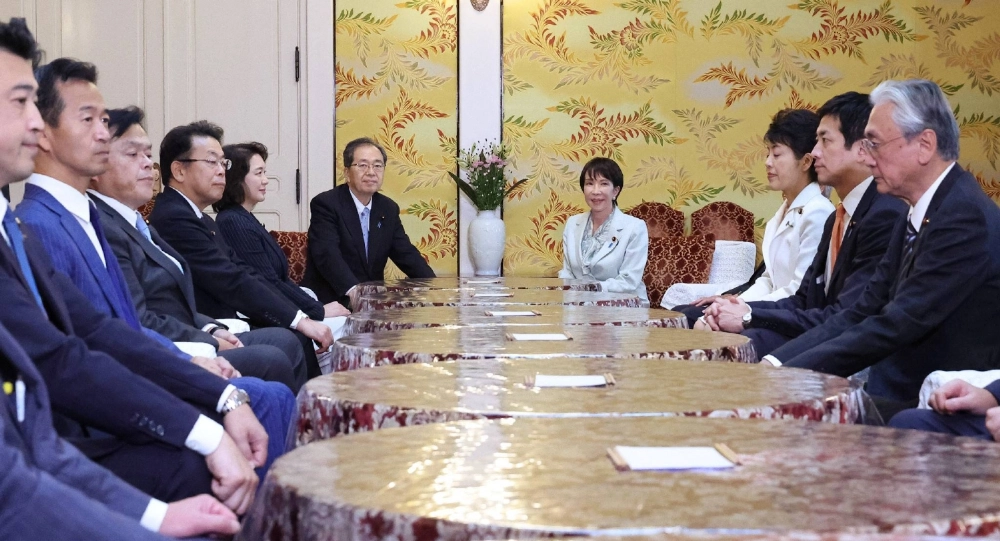LDP and Komeito's Shaky Ties Throw Doubt on Takaichi Becoming Prime Minister
Coalition Partners Grapple with Ideological and Ethical Clashes Amid Leadership Transition
By Japan News Desk
Uncertain Path to Powerhouse
TOKYO — In a dramatic twist to Japan's political landscape, Sanae Takaichi's recent election as president of the Liberal Democratic Party (LDP) on October 4 has ignited tensions within the ruling coalition, casting serious doubts on her ascension to prime minister. Komeito, the LDP's longstanding junior partner known for its pacifist leanings, has signaled reluctance to back Takaichi in the upcoming parliamentary vote, potentially forcing her to court opposition support in a fragmented Diet where the coalition lacks a majority.
The surprise choice of Takaichi, a staunch conservative with hawkish foreign policy views, has rattled Komeito members who fear her positions could undermine the party's core values on peace, historical reflection, and inclusive policies toward foreign nationals. This discord comes at a critical juncture, as parliament prepares to convene later this month to select the next leader, amidst pressing issues like a supplementary budget to combat inflation and international engagements including a possible visit from U.S. President Donald Trump.
Takaichi's appointment of Koichi Hagiuda, a figure tainted by the Abe faction's slush fund scandal, as executive acting secretary-general has further strained relations. Hagiuda, who faced a one-year LDP suspension in April 2024 for failing to report over ¥27 million in funds, embodies the ethical lapses Komeito demands the new leadership address firmly. Without a swift coalition agreement, Takaichi risks abstention or defection from Komeito votes, opening the door for opposition maneuvers.
Opposition dynamics add to the intrigue, with the Democratic Party for the People (DPP) emerging as a potential kingmaker. DPP leader Yuichiro Tamaki shares economic reform goals with Takaichi, such as abolishing the gasoline tax and raising the income tax threshold, though specifics diverge. Reports of a clandestine meeting between the two leaders underscore the high-stakes negotiations unfolding behind closed doors.
As Japan's political elite navigates this precarious terrain, the outcome could reshape the government's stability and policy direction, particularly on security, economy, and historical accountability. With the autumn parliamentary session's start date still undecided, the clock is ticking for Takaichi to mend fences or pivot to unlikely alliances in her bid for the premiership.
Why This Rift Matters for Japan's Future
At its heart, the fraying bond between the LDP and Komeito transcends personal leadership styles; it strikes at the foundational compromises that have sustained Japan's postwar coalition government for decades. Takaichi's hawkish conservatism clashes with Komeito's pacifist ethos, rooted in the Soka Gakkai Buddhist movement's emphasis on peace and social welfare, potentially eroding the coalition's ability to pass key legislation on defense, immigration, and fiscal policy. This vulnerability is amplified by the LDP's loss of its Diet majority in recent elections, making Komeito's 32 seats indispensable—yet now in jeopardy.
The slush fund scandal's lingering shadow, exemplified by Hagiuda's role, underscores broader public distrust in political financing, a red line for Komeito's supporters who prioritize transparency and ethical governance. Failure to align on these issues could not only derail Takaichi's premiership but also trigger a cascade of opposition unity, empowering figures like Tamaki to demand concessions on tax reforms and energy policies. In an era of rising geopolitical tensions and domestic economic pressures, this internal coalition strife risks paralyzing decision-making at a time when Japan needs unified leadership to address inflation, U.S. alliances, and regional summits like APEC.
Ultimately, the saga highlights the fragility of Japan's hybrid democracy, where ideological purity battles pragmatic power-sharing. If unresolved, it could force a reevaluation of coalition formulas, inviting more volatile multiparty bargaining and altering the trajectory of Japanese politics toward greater unpredictability and reform—or deeper division.
Tensions Over Hawkish Policies and Historical Views
Komeito's unease with Takaichi stems partly from her conservative stance on national security and history, which contrasts sharply with the party's commitment to Article 9's pacifist principles. Members worry that her views might lead to aggressive military expansions or downplay Japan's wartime atrocities, alienating Komeito's base and complicating bilateral relations with neighbors like China and South Korea.
The Slush Fund Scandal's Lasting Impact
The appointment of Hagiuda has reignited debates over political accountability, as his involvement in unreported funds from the Abe faction—totaling over ¥27 million—directly contravenes Komeito's push for stringent reforms. This move signals to critics that Takaichi prioritizes loyalty over ethics, further eroding trust within the coalition.
Opposition Courting and Strategic Maneuvers
Beyond coalition woes, Takaichi's overtures to the DPP illustrate the fluid alliances forming. Shared goals on tax cuts could bridge gaps, but Tamaki's evasive responses hint at leverage plays, while the CDP's willingness to back him over Noda signals a tactical shift to consolidate anti-LDP votes.
Key Voices Shaping the Debate
“The unreported slush fund matters have left our party's supporters deeply unsettled, and we cannot overlook the ethical implications of appointing someone like Hagiuda to such a pivotal role. While we found some common ground on security and historical issues during our meeting, the divide on political financing remains wide. We agreed only to continue discussions, but without a firm commitment to transparency and reform, it's hard to see how we can align our values for a stable coalition moving forward,” Komeito leader Tetsuo Saito stated after his Tuesday meeting with Takaichi, emphasizing the grassroots pressure influencing his stance.
“There's absolutely no point in forging a coalition with an LDP president whose priorities clash so fundamentally with our core principles of peace, inclusivity, and clean governance. If we cannot hammer out an agreement that respects Komeito's values, we will not extend our support in the prime ministerial vote. Abstaining or seeking alternative partnerships isn't ideal, but it's a necessary safeguard for our supporters and the nation's democratic integrity,” Saito added in a broader reflection on the coalition's future.
“I’m meeting a variety of influential figures across the political spectrum in diverse settings to explore potential alignments, but I must refrain from divulging details about each individual encounter, including who I met, when, or what specific topics we covered. These conversations are exploratory and aimed at finding common ground on economic revitalization, but any premature disclosures could undermine the delicate negotiations at play in this pivotal moment for Japan's leadership transition,” DPP leader Yuichiro Tamaki remarked during a Tuesday press conference, alluding to his reported Sunday night discussion with Takaichi.
“The Constitutional Democratic Party is not fixated on nominating Yoshihiko Noda as our prime ministerial candidate; instead, we're approaching this from a strategic viewpoint of building opposition consensus. We need to identify a figure who can rally enough votes to surpass the LDP's choice of Takaichi, fostering unity across parties on key issues like economic relief and constitutional safeguards. This flexibility is crucial in a divided Diet where no single bloc holds sway,” CDP Secretary-General Jun Azumi explained on Tuesday following a meeting with Nippon Ishin no Kai representatives.
“During our discussions, Azumi half-jokingly floated the idea of the CDP backing Tamaki as a unified opposition pick, but let's be clear: while we share some reformist zeal, profound differences persist on critical fronts like constitutional revision, national security enhancements, and the strategic role of nuclear power in our energy future. These divergences aren't trivial; they shape our policy platforms and voter bases, making any hasty alliance fraught with risks that could dilute our distinct visions for Japan's path ahead,” DPP Secretary-General Kazuya Shimba told reporters after meeting Azumi, highlighting the challenges of cross-party cooperation.
Historical Roots of the Coalition Dynamic
The LDP-Komeito alliance, forged in 1999, has weathered numerous storms, from economic crises to security debates, largely due to mutual dependence—the LDP's organizational might complementing Komeito's reliable voter turnout via Soka Gakkai. However, scandals like the Abe faction's ¥27 million unreported funds in 2024 exposed fault lines, forcing suspensions and reforms that Komeito championed, setting the stage for today's impasse.
Takaichi's rise, marked by her advocacy for shrine visits and defense hikes, echoes past conservative surges under Abe, but in a post-scandal era, it amplifies Komeito's calls for ethical resets and policy moderation on immigration and history education.
Navigating Toward Resolution or Rupture
As negotiations drag on, the undecided parliamentary schedule looms large, delaying not just the PM vote but also vital economic packages against soaring prices. A Takaichi premiership without Komeito could invite instability, yet mending ties might demand concessions on appointments and reforms, testing her nascent leadership.
In this high-wire act, Japan's democracy hangs in balance—will pragmatism prevail, or will ideological rifts redefine power-sharing in Tokyo?
Categories, Keywords, and Sources
Categories: Japan Politics, LDP Leadership, Coalition Government, Prime Minister Election
Keywords: Sanae Takaichi, LDP Komeito ties, Japanese prime minister, political slush funds, opposition alliances, hawkish policies
Source: The Japan Times | For more on Banzai Japan news, visit our homepage.
- 5 October 2025 Transfer gossip - October 10, 2025
- Blast at Tennessee military explosives plant - October 10, 2025
- Who are the Pink Ladies Anti migrant hotel protesters - October 10, 2025

